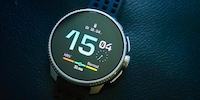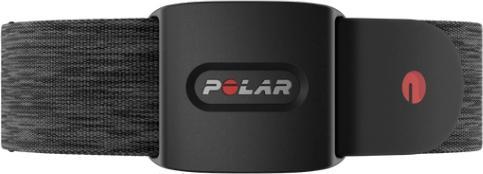

Arm candy? Getting my pulse racing with the Polar Verity Sense
Depending on the sport, heart rate monitors can be annoying. Optical heart rate sensor Polar Verity Sense is comfortable to wear around your arm – and is supposedly as accurate as a chest strap with an ECG. I worked up a sweat to find out.
Years ago, I put on a chest strap to measure my athletic performance. It was difficult and uncomfortable. I was also unhappy with adding a sports watch. I can’t wear them for all sports. Hopefully, Polar’s arm band solves all of these problems.
Measuring the heart rate via optical sensor, the Polar Verity Sense is said to be a competitor for the chest strap. This is exactly what I want to find out. I set the H10 chest strap and the Verity Sense against each other in a range of different sports. May the best one win!
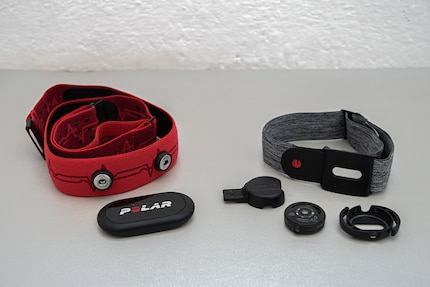
Source: Michelle Brandle
ECG versus OHR: two different measurement techniques
While the H10 chest strap works via electrocardiogram (ECG), the Polar Verity Sense has an optical heart rate (OHR) sensor. But what’s the difference?
An ECG provides a visual representation of the electrical signals emanating from the heart. With each beat of your heart, electrical signals move around the body. Electrodes can measure these changes. The best place to put them is the chest because it’s closest to the heart.
OHR measurements use LEDs and a photodiode to measure the changes in the size of your blood vessels under the skin. This works well on the wrist, e.g. with a sports watch or as an arm band.
The ECG is designed to provide accurate readings for high-intensity exercise and extreme movement. It’s also less sensitive to temperature differences and perspiration. An OHR in a sports watch offers the option to monitor and view your data around the clock.
Without claiming to be a solution for extreme sports, it seems to be a suitable option for me. But the two devices I’m testing both have their strengths and weaknesses.
Secret favourite: the Polar Verity Sense
Slim and athletic, the Polar Verity Sense is a flexible strap that I simply slip over my arm. Or a leg, if needed. It comes with an optical heart rate sensor with a button. You can just click it into the housing provided on the belt and off you go. I use the button to switch between three modes: normal measurement via app or watch, independent measurement – with automatic storage of around 500 hours of training (16 megabytes of memory) – and a swim mode.
There’s also a USB housing where I click in the pulse sensor and connect it to my PC. I can view my data using a Polar programme (https://flow.polar.com/diary). This is the first way to evaluate the training files. The second is directly on your smartphone (iOS and Android) via Bluetooth with the free Polar Flow app (https://play.google.com/store/apps/details?id=fi.polar.polarflow&hl=en_GB&gl=US&pli=1). An account is required for both variants. The computer and mobile versions are then automatically synchronised.
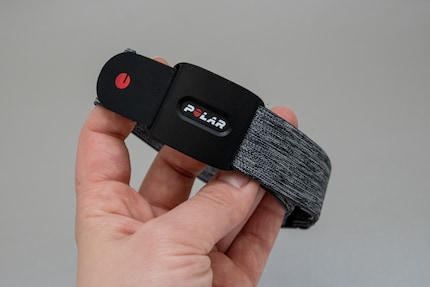
Source: Michelle Brandle
The strengths
The biggest plus points are that I can slip it on my arm quickly and I don’t need a watch. I can switch between the three modes with just one button and, as a swimmer, I can also measure my lengths by attaching the sensor to my goggles. There’s a clip included for this. The heart rate sensor is waterproof to 50 metres.
The weaknesses
All in all, the small 45 mAh battery lasts up to 30 hours of training before it runs out. This is much shorter compared to the chest strap’s running time of 400 hours. However, you can charge it from the battery and don’t have to change batteries. But you also need a power supply unit with a USB-A connection. Depending on the power supply, charging takes about an hour. For a spontaneous session, you can charge the battery for just 10 minutes for a two-hour runtime.
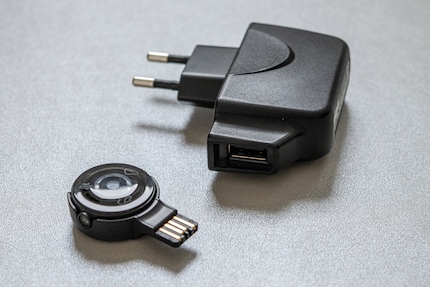
Source: Michelle Brandle
The optical heart rate sensor is said to be less accurate during intense sports or jerky movements, but Polar believes that there’s little difference. I put this to the test and recorded my findings in the facts and figures below.
Popular competitor: the Polar H10
According to Polar, medical researchers and top athletes from all over the world trust the heart rate sensor because of its precision. For example, entire sports teams can each wear one so that their coach can monitor everyone at the same time. As a casual athlete, I don’t need that, buts the H10 still has benefits.
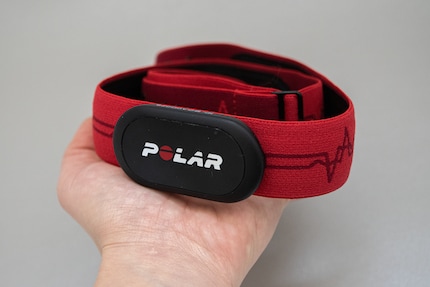
Source: Michelle Brandle
With up to 400 hours of battery life, the H10 lasts much longer than the Verity Sense. The silicone dots on the inside stop it slipping down so quickly. Accurate measurement is the H10’s biggest strength.
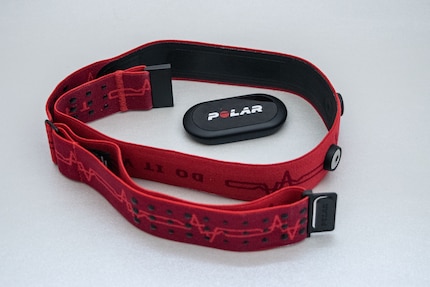
Source: Michelle Brandle
The weaknesses
The H10 needs to have the best possible contact with the skin. That’s why you have to moisten it with some water before wearing it. It should also be quite tight so that it doesn’t slip down despite the silicone dots. After wearing, you have to disconnect the sensor from the strap to prevent the battery draining further. And last but not least, you need a smartphone with an app or a sports watch. You can’t start it by yourself.
Rules of the game: comparing measurements for different sports
With all the pros and cons of the two straps in mind, I start testing them. I let off steam with various sports and always wore both straps to take parallel measurements and compare them. From calm to hyperactive, I did a bit of everything: yoga, jogging, weight training and boxing. To avoid any measuring errors, I logged the sports several times and took the best results.
Real-life experience
The Polar Verity Sense is quick to put on and take off. It also doesn’t slip when jogging or boxing. I like the fact that I don’t need an app or watch. When synchronising later, however, I notice that the sensor doesn’t recognise or differentiate between sports. They’re always shown as «other indoor sport» in my history. If that bothers you, you have to use the app and select the sport there.
If I connect the sensor to the smartphone app once via Bluetooth, it automatically synchronises with my stored profile. If I don’t want to use an app, I plug the sensor in the USB housing into the computer and the data is automatically linked to my Polar profile.
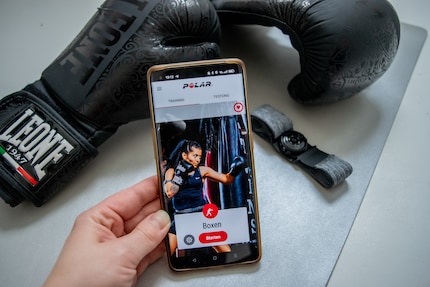
Source: Michelle Brandle
There’s more fiddling with the chest strap when putting it on and even if I wear it relatively tight, it occasionally slips down when I’m jumping and running. That’s probably because I don’t have much room to pull it up under my bra and I’m sweating quite a bit underneath it. I find it annoying when doing exercises and moves lying down for some strength exercises and yoga sessions because the sensor presses against my chest.
I have to have my smartphone ready to start recording. But it’s pretty straightforward – even if I’m training in the farthest corner of the gym away from my smartphone. I select the desired sports in the app. I can also turn on an assistant in the app which informs me via my headphones whether I’m training in the fitness or fat burning area. When I train on the endurance machines in the gym, my heart rate is transmitted directly to the machine and displayed by the H10. Unfortunately, this doesn’t work with the Polar Verity Sense.
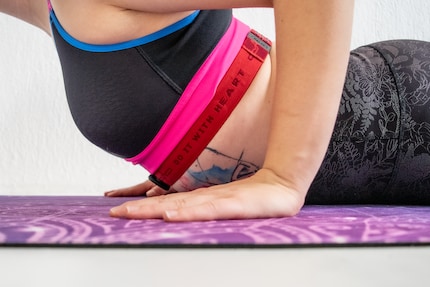
Source: Michelle Brandle
Measurements
I wore both belts for the various sports and found pros and cons in my measurement results.
Contrary to my expectations, yoga was the most difficult sport to compare. Both straps are tight during the slow exercises, but there are extreme highs and lows in the heartbeats. The recordings of the two straps are slightly staggered, but this doesn’t affect the result. The result is also not influenced by the many peaks recorded by the chest strap that the arm band didn’t measure.
So, on average, there’s not much difference. My heart rate is 100 beats per minute with the arm band and 99 beats per minute with the chest strap. The chest strap measured my highest heart rate at 140 and the arm band at 137. I burned 234 kilocalories according to Verity Sense and a little less (207) according to the H10.
When boxing, I was curious to see whether the jerky movements would cause the straps to slip and falsify the result. The arm band fit perfectly. The chest strap sometimes shifted a bit. Once, it slipped all the way down. The peaks are shown in more detail by the ECG on the chest strap. The optical sensor on my arm obviously has some trouble and uses a middle ground.
The summary is also interesting. According to both sensors, my heart beat an average of 159 times per minute. The areas are also similar: between 72 and 196 beats for the arm band and between 69 and 196 beats for the chest strap. I burned 541 kilocalories with the arm band and 608 with the chest strap. The latter would cover a large cappuccino after training.
Strength training shows similar problems. I see a big difference after 10 minutes. There’s a big peak on the chest strap, which is missing on the optical heart rate sensor. There are other smaller outliers, but overall they coincide well.
Here, too, I have the same average heart rate: 128 beats per minute. With the optical sensor, my pulse ranges from 83 to 178 beats and with the ECG from 82 to 180. With 238 kilocalories with the arm band, I burned a little less than the 246 kilocalories with the chest strap – a small difference.
As endurance training, jogging involves fewer extreme ups and downs. My low points come mostly from waiting at the many traffic lights around the city. At the very beginning, you can still see a few differences, otherwise they match up very well. A more even pulse is measured well by both devices. Here, too, my average heart rate is the same for both sensors and the calories for the optical sensor are again slightly below the ECG sensor.
In the end, it’s the average – and the fun – that counts
The optical pulse sensor often produces average values, while the ECG is better at detecting outliers. However, the averages and end results are similar.
But I don’t need to know everything in detail. Visualising general improvements, how long my session was and how intense the training was as a whole is enough for me. The Polar Verity Sense is ideal for this.
While I don’t need a watch with either, I definitely have to have a smartphone with me to start measuring with the chest strap. The H10’s battery life is significantly longer. Charging the Verity Sense takes just under an hour, and 10 minutes of charging is sufficient for a longer training session.
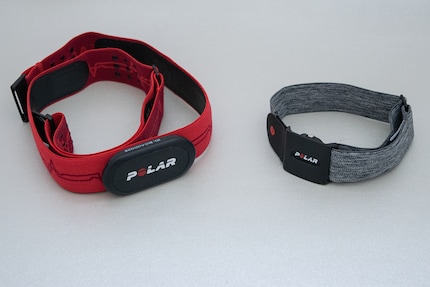
Source: Michelle Brandle
Overall, besides the measurements, comfort is also important to me. If I don’t want to wear the measuring device during sport, there’s no point. That’s where the Polar Verity Sense impresses, as I’d hoped at the outset. It’s quick to put on and sits comfortably during all sports. The H10 bothered me during the odd exercise and sometimes slipped down during sweaty sessions.
The devices are very close in price. You can pick up the Polar Verity Sense for 97.20 francs or 88 euros and the H10 for 79 francs or euros. The H10 is the best option for precise measurements during extreme, long sports sessions. You just need a smartphone or a watch to get started. The Polar Verity Sense is ideal for endurance and casual sports. It’s comfortable, stable and doesn’t require any accessories. I definitely enjoy boxing with it and it doesn’t disturb my flow during yoga.
In my world, Super Mario chases Stormtroopers with a unicorn and Harley Quinn mixes cocktails for Eddie and Peter at the beach bar. Wherever I can live out my creativity, my fingers tingle. Or maybe it's because nothing flows through my veins but chocolate, glitter and coffee.



